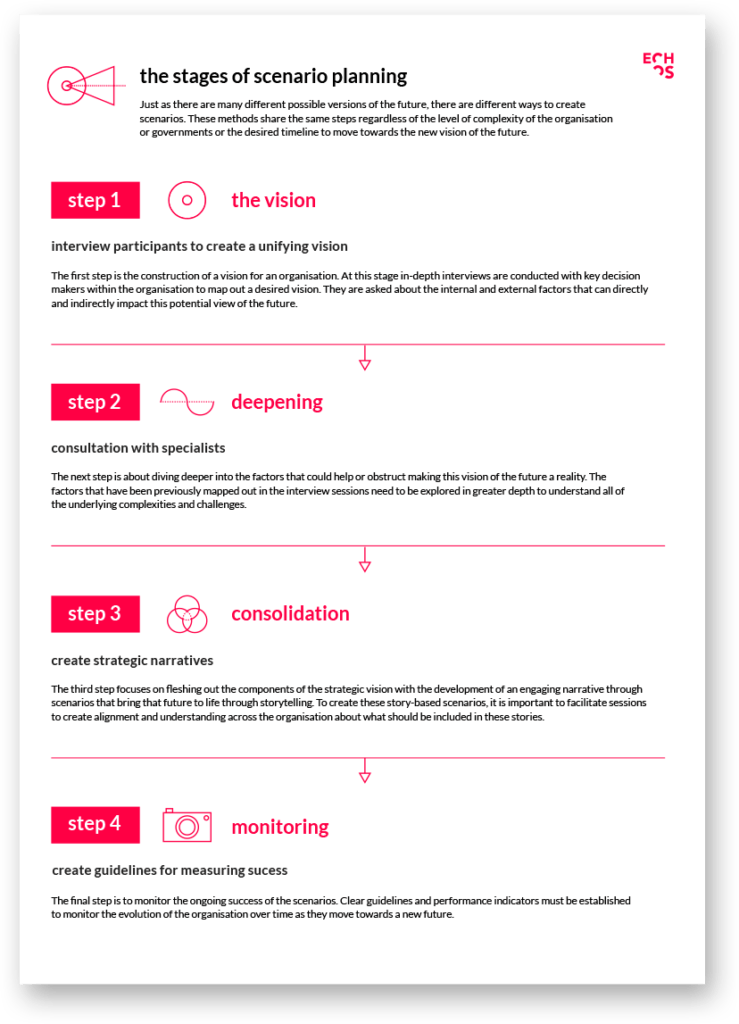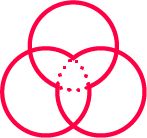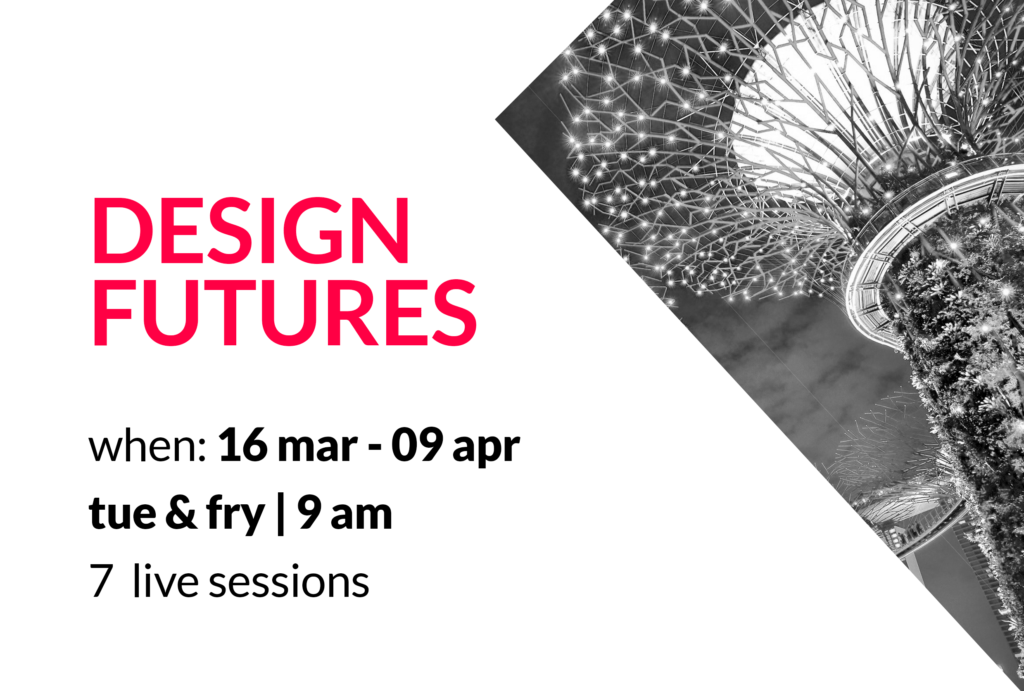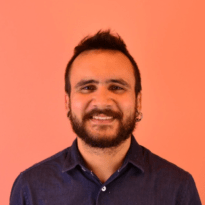The history of future scenario planning is short, when contrasted with the years into the future it can plan for. The first person credited with working with future scenarios is Herman Khan who developed the practice of telling future stories in his work for the US Military and the RAND Corporation in the 1950’s.
Prior to Khan’s work, future planning was a linear graph with only one possible outcome for the future. And it didn’t take into account small trends or signals that could impact the future especially, in the highly dynamic areas of social movements.
Khan went on to develop processes of future scenarios for medium- and long-term projections. And not just one future, on one timeline, he designed multiple options for the future. Khan along with Anthony J. Wiener wrote, ‘The Year 2000: A framework for Speculation on the Next Thirty-three Years ‘. This book used the term ‘scenario’ together with ‘prospective’ for the first time.
Co-author Anthony Wiener called it “reducing the role of thoughtlessness” in making societal choices. Clarification of what would be a better future was the goal, not to create prophecies.
Kahn persisted in developing ways to clarify the future with scientists and researchers that culminated in the creation of the ‘Delphi Method’. This process surveys a group of specialists to arrive at an opinion about the future. The specialists respond to several rounds of questionnaires, and the responses are collated and shared with the group after each round. Using a wide range of expert opinions minimises the risks of relying on a single expert that could lead to bias.
The method is especially useful when there is no true or knowable answer, as is the case with long-range scenario planning. This process is still used today to help formulate possible future scenarios, and is a key method employed in our work at Echos.
While the United States was the first country to focus on the development of future scenarios for the medium and long term, it was a French philosopher who introduced a new way of thinking about futures.
Gaston Berger used the term prospective as a way to shape envisioning multiple possible future scenarios. Looking at various prospective or likely futures helped to minimise the risk of failures by providing more than one option. Berger employed this process of thinking about prospective futures to assist with the reconstruction of post-war Europe. This gave rise to using future scenario planning for economic and societal problems.
Design Futures Are Speculative
At Echos, we understand the power of imagination. Speculative futures design is a method of imagining new possible futures. Not just one but a range of different scenarios. These futures are developed to address big societal problems and or create products and services for those different scenarios.
Currently, organisations, governments and companies use the method of speculative scenarios to define various visions of the short-, medium- and long-term possible futures. Creating a number of prospective futures allows for exploration of the multiple drivers and trends that can influence these futures and create strategies to minimise the impact of unexpected consequences.
We are living in a rapidly evolving world on multiple fronts, such as climate change, evolution of the pandemic and political polarities. It is critical to build sustainable outcomes that engage with all of society to create desired and achievable visions of new futures.
The Stages Of Scenario Planning
Just as there are many different possible versions of the future, there are different ways to create scenarios. These methods share the same steps regardless of the level of complexity of the organisation or governments or the desired timeline to move towards the new vision of the future.
download the tool here: https://drive.google.com/file/d/11s-gMCJVPRPEz8kRtVtjsL72aa-TGycb/view?usp=sharing
Vision
The first step is the construction of a vision for an organisation. At this stage in-depth interviews are conducted with key decision makers within the organisation to map out a desired vision. They are asked about the internal and external factors that can directly and indirectly impact this potential view of the future.
For a company the interviews should be conducted at the C-suite or management level. For projects focused on a society, it should be the government or the citizens themselves. It is important to understand the needs of the organisation or the society to create a vision that includes them. It also maps out the factors that can help or hinder this vision coming into being.
Deepening
The next step is about diving deeper into the factors that could help or obstruct making this vision of the future a reality. The factors that have been previously mapped out in the interview sessions need to be explored in greater depth to understand all of the underlying complexities and challenges.
This is done by engaging with specialists who have deep knowledge of the potential future advantages and disadvantages of each of the factors. The subject matter experts participate in workshops to identify trends that could impact the medium- and long-term futures of the organisation or government.
This is also where weak signals come into play. Paying attention to weak signals is one of the most important parts of speculating about the future. The experts look at pre-trends that are emerging around the fringes of an industry. How many are likely to form into larger movements? This will help organisations understand how to proceed with the next step. The process of creating stories for each scenario.
Consolidation
The third step focuses on fleshing out the components of the strategic vision with the development of an engaging narrative through scenarios that bring that future to life through storytelling. To create these story-based scenarios, it is important to facilitate sessions to create alignment and understanding across the organisation about what should be included in these stories.
This helps to access and understand the level of commitment with the organisation to not only uphold the visions presented within the scenarios, but also to ensure the narratives resonate with the various audiences. Do they feel authentic? Do they help to motivate the different stakeholders to move towards the vision of the future together?
Monitoring
The final step is to monitor the ongoing success of the scenarios. Clear guidelines and performance indicators must be established to monitor the evolution of the organisation over time as they move towards a new future.
For businesses the use of KPIs – Key Performance Indicators and OKR – Key Objectives and Results are the standard for monitoring the success of ongoing projects. When working toward new futures it is important to be open to recalibrating objectives or goals as the future unfolds. There are many unknowns ahead; it is important to be flexible and open to making adjustments along the way of what success looks like.
For monitoring the growth and change at societal and government level, initiatives like the SDGs – Sustainable Development Goals of the UN is an international standard for monitoring goals. They are 17 goals that create guidelines for a global partnership to develop better futures for the planet. These goals recognise that ending poverty and other deprivations must go hand-in-hand with strategies that improve health and education, reduce inequality, and spur economic growth – all while tackling climate change and working to preserve our oceans and forests.
In addition, the ISO 37101 framework developed by the ISO organisation are indicators that guide and measure the performance and quality of life. The ISO is an independent, non-governmental international organisation with a membership of 165 national standards bodies. The ISO 37101 can be applied to any city, municipality or local government that wants to measure its performance in a comparable and verifiable manner, regardless of its size and location.
Regardless of the size and scope of the project and the level of complexity, any scenario must be constantly monitored and updated based on new factors or signs previously not identified. All of the above frameworks are guides and must be adjusted accordingly.
Creating Scenarios
It is important to remember that each organisation or society is different and there are no hard and fast rules for what is considered the correct approach. When creating scenarios there is no optimal number needed for the organisations to start moving toward their new visions of the future.
When deciding on the number of scenarios to create it is important to consider the trends that will impact the organisation’s vision. For example, there may be two drivers that will affect an organisation’s future. To flesh out those drivers a scenario should be fleshed out for each.
That being said the creation of between 2 and 4 scenarios is the industry standard. Any more than that can lead to unnecessary complexity and becomes counterproductive.
When working with 4 scenarios for example, they are organised on a matrix of 4 quadrants, one for each scenario. The axes are the drivers that act as unknowns that will directly influence the organisation. For an organisation it could be factors directly related to its performance such as profit or growth. Within a government context it could be climate change or the economy.
Create A New Future
Once the scenarios have been developed, the biggest challenge is its implementation and constant monitoring within the organisation.
As the great poet and artist Miró says, “Tomorrow does not exist yet”, and for that reason, everything is likely to be changed. Even the most accurate and optimistic scenarios designed in 2019 did not expect a virus that would impact the world the way it did in 2020.
Along with building scenarios, organisations must focus on fostering resilience and adaptability into its ongoing management plan. This is critical to dealing with adverse situations and surviving over time. This means developing mechanisms for constant monitoring of trends and drivers emerging in our environments. Proper monitoring helps to readjust the paths and prosper in an uncertain future.
The key to thinking and acting with the future in mind is linked to acquiring new skills. Get in touch to learn more about our Design Futures learning experience or how we can assist your organisation to design its future.
—
Follow us on social
Instagram – Facebook – LinkedIn – Youtube – Spotify
How Can We Help?
- For training and Innovation Journeys in your company: check out our in-house course offering.
- For upcoming courses in your region: visit our website.
- For upcoming events in your region: look at our event calendar.
- If you have a special project and would like to use Echos’ consultancy services: send us an email.
- Want to speak to a real person? Call us on 1300 502 006









